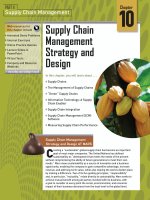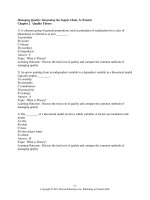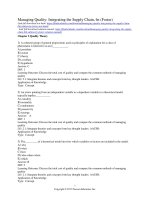Lecture Operations management: Creating value along the supply chain (Canadian edition) - Chapter 17
Bạn đang xem bản rút gọn của tài liệu. Xem và tải ngay bản đầy đủ của tài liệu tại đây (1.63 MB, 48 trang )
OPERATIONS MANAGEMENT:
Creating Value Along the Supply Chain,
Canadian Edition
Robert S. Russell, Bernard W. Taylor III, Ignacio Castillo, Navneet Vidyarthi
§
CHAPTER 17
Scheduling
1
§
Learning Objectives
Objectives in Scheduling
Loading
Sequencing
Monitoring
Advanced Planning and Scheduling Systems
Theory of Constraints
Employee Scheduling
17-2
§
What is Scheduling?
Last stage of planning before production occurs
Specifies when labor, equipment, and facilities are
needed to produce a product or provide a service
17-3
§
Scheduled Operations
Process Industry
Linear programming
EOQ with noninstantaneous
replenishment
Mass Production
Assembly line balancing
Project
Project -scheduling
techniques (PERT, CPM)
Batch Production
Aggregate planning
Master scheduling
Material requirements
planning (MRP)
Capacity requirements
planning (CRP)
17-4
§
Objectives in Scheduling
Meet customer due
dates
Minimize job lateness
Minimize response
time
Minimize completion
time
Minimize time in the
system
Minimize overtime
Maximize machine or
labor utilization
Minimize idle time
Minimize work-inprocess inventory
17-5
§
Shop Floor Control (SFC)
Schedule and monitor day-to-day job shop
production
Also called production control and production
activity control (PAC)
Performed by production control department
Loading - check availability of material, machines, and
labor
Sequencing - release work orders to shop and issue
dispatch lists for individual machines
Monitoring - maintain progress reports on each job until it
is complete
17-6
§
Loading
Process of assigning work to limited resources
Perform work with most efficient resources
Use assignment method of linear programming to
determine allocation
17-7
§
Assignment Method
1. Perform row reductions
subtract minimum value in each
row from all other row values
2. Perform column reductions
subtract minimum value in each
column from all other column
values
3. Cross out all zeros in matrix
use minimum number of horizontal
and vertical lines
4. If number of lines equals number
of rows in matrix, then optimum
solution has been found. Make
assignments where zeros
appear
‾
‾
‾
‾
Else modify matrix:
subtract minimum uncrossed
value from all uncrossed values
add it to all cells where two lines
intersect
other values in matrix remain
unchanged
5. Repeat steps 3 and 4 until
optimum solution is reached
17-8
§
Assignment Method
17-9
§
Assignment Method
17-10
§
Assignment Method - Setup
Solution goes here
Only 1 leader can
be assigned to
each project
Click “Solve” for
solution
Sum of all rows and
columns = 1
17-11
§
Assignment Method - Solution
17-12
§
Sequencing
Prioritize jobs assigned to a resource
If no order specified use first-come first-served (FCFS)
Other Sequencing Rules
FCFS - first-come, first-served
LCFS - last come, first served
DDATE - earliest due date
CUSTPR - highest customer priority
SETUP - similar required setups
SLACK - smallest slack
CR - smallest critical ratio
SPT - shortest processing time
LPT - longest processing time
17-13
§
Minimum Slack & Smallest Critical Ratio
SLACK considers both work and time remaining
CR recalculates sequence as processing
continues and arranges information in ratio form
17-14
§
Sequencing Jobs Through One Process
Flow time (completion time)
Time for a job to flow through system
Makespan
Time for a group of jobs to be completed
Tardiness
Difference between a late job’s due date and its
completion time
17-15
§
Simple Sequencing Rules
17-16
§
Simple Sequencing Rules: FCFS
17-17
§
Simple Sequencing Rules: DDATE
17-18
§
Simple Sequencing Rules: SLACK
17-19
§
Simple Sequencing Rules: SPT
17-20
§
Simple Sequencing Rules: Summary
17-21
§
Sequencing Jobs Through Two Serial
Process
17-22
§
Sequencing With Excel
17-23
§
Johnson’s Rule
17-24
§
Johnson’s Rule
17-25
§









